Potential of Aframomum melegueta and Xylopia aethiopica Against Taenia spp.: Plant-Based Remedies as Novel Anthelmintics
Abstract
1. Introduction
2. Results
2.1. Bio-Guided Extraction and Partitioning
2.2. Anthelmintic Activity of AM and XA Fractions on Taenia spp. Worms
2.3. Anthelmintic Activity of HE and Fractions of AM and XA on Taenia Cells
2.3.1. Taenia Worm Cells’ Extraction Before Treatment with Extracts and PI Staining
2.3.2. Treatment of Taenia Worms with Extracts Before Cell Extraction and PI Staining
2.4. Irreversibility of the Effect of AM and XA Fractions on Taenia spp. Worms
3. Discussion
4. Materials and Methods
4.1. Plant Material
4.2. Plant Extraction
4.3. Bio-Guided Partition
4.4. Collection of Worms
4.5. Anthelmintic Activity on Taenia Worms
4.6. Anthelmintic Activity on Taenia Cells
4.7. Propidium Iodide Staining of Taenia Cells
4.8. Assessment of Motility Recovery of Taenia spp. Worms
4.9. Statistical Analysis
5. Conclusions
Author Contributions
Funding
Institutional Review Board Statement
Informed Consent Statement
Data Availability Statement
Acknowledgments
Conflicts of Interest
Abbreviations
| AF | Aqueous fraction |
| AM | Aframomum melegueta |
| CF | Chloroform fraction |
| DCMF | Dichloromethane fraction |
| EF | Ether fraction |
| FBS | Fetal bovine serum |
| HE | Hydroethanolic extract |
| PBS | Phosphate-buffered saline |
| RPMI | Roswell Park Memorial Institute medium |
| XA | Xylopia aethiopica |
References
- Gebrie, M.; Engdaw, T.A. Review on taeniasis and its zoonotic importance. Eur. J. Appl. Sci. 2015, 7, 182–191. [Google Scholar]
- Ito, A.; Wandra, T.; Yamasaki, H.; Nakao, M.; Sako, Y.; Nakaya, K.; Margono, S.S.; Suroso, T.; Gauci, C.; Lightowlers, M.W.; et al. Cysticercosis/taeniasis in Asia and the Pacific. Vector-Borne Zoonotic Dis. 2004, 4, 95–107. [Google Scholar] [CrossRef] [PubMed]
- Jansen, F.; Dorny, P.; Gabriël, S.; Dermauw, V.; Johansen, M.V.; Trevisan, C. The survival and dispersal of Taenia eggs in the environment: What are the implications for transmission? A systematic review. Parasit. Vectors 2021, 14, 88. [Google Scholar] [CrossRef] [PubMed]
- Galán-Puchades, M.T.; Fuentes, M.V. Taenia asiatica: The most neglected human Taenia and the possibility of cysticercosis. Korean J. Parasitol. 2013, 51, 51–54. [Google Scholar] [CrossRef]
- Mlowe, F.; Karimuribo, E.; Mkupasi, E.; Churi, A.; Nyerere, A.D.; Schmidt, V.; Ngowi, H.; Winkler, A.S.; Mlangwa, J. Challenges in the Diagnosis of Taenia solium Cysticercosis and Taeniosis in Medical and Veterinary Settings in Selected Regions of Tanzania: A Cross-Sectional Study. Vet. Med. Int. 2022, 2022, 1–15. [Google Scholar] [CrossRef]
- Okello, A.L.; Thomas, L.F.J.R.M.; Policy, H. Human taeniasis: Current insights into prevention and management strategies in endemic countries. Risk Manag. Healthc. Policy 2017, 10, 107–116. [Google Scholar] [CrossRef]
- Edao, A.; Dima, F.G.; Deressa, F.B. Prevalence of bovine cysticercosis and status of human taeniasis in and around Asella town, Tiyoworeda, south east Ethiopia. Glob. J. Med. Res. 2016, 16, 18–26. [Google Scholar]
- Parija, S.C. Taeniasis. In Textbook of Parasitic Zoonoses, 1st ed.; Parija, S.C., Chaudhury, A., Eds.; Springer: Singapore, 2022; pp. 337–351. [Google Scholar]
- Wardle, M.T.; Allen, S.E.; Gamboa, R.; Vilchez, P.; O’Neal, S.E.; Muro, C.; Lescano, A.G.; Moyano, L.M.; Gonzalvez, G.E.; González, A.E.; et al. Mass chemotherapy with niclosamide for the control of Taenia solium: Population-based safety profile and treatment effectiveness. Lancet Reg. Health Am. 2024, 38, 100876. [Google Scholar] [CrossRef]
- Lateef, M.; Zargar, S.A.; Khan, A.R.; Nazir, M.; Shoukat, A. Successful treatment of niclosamide- and praziquantel-resistant beef tapeworm infection with nitazoxanide. Int. J. Infect. Dis. 2008, 12, 80–82. [Google Scholar] [CrossRef]
- Thomas, C.M.; Timson, D.J. The Mechanism of Action of Praziquantel: Can New Drugs Exploit Similar Mechanisms? Curr. Med. Chem. 2020, 27, 676–696. [Google Scholar] [CrossRef]
- World Health Organization. WHO Guidelines on Management of Taenia solium Neurocysticercosis, 1st ed.; World Health Organization: Geneva, Switzerland, 2021. [Google Scholar]
- Fissiha, W.; Kinde, M.Z. Anthelmintic Resistance and Its Mechanism: A Review. Infect. Drug Resist. 2021, 14, 5403–5410. [Google Scholar] [CrossRef] [PubMed]
- Twumasi, E.B.; Akazue, P.I.; Kyeremeh, K.; Gwira, T.M.; Keiser, J.; Cho-Ngwa, F.; Flint, A.; Anibea, B.; Bonsu, E.Y.; Amewu, R.K.; et al. Antischistosomal, antionchocercal and antitrypanosomal potentials of some Ghanaian traditional medicines and their constituents. PLoS Negl. Trop. Dis. 2021, 14, 0008919. [Google Scholar] [CrossRef]
- Tandon, V.; Yadav, A.; Roy, B.; Das, B. Phytochemicals as cure of worm infections in traditional medicine systems. Emerg. Trends Zool. 2011, 16, 351–378. [Google Scholar]
- Chaughule, R.; Barve, R. Role of herbal medicines in the treatment of infectious diseases. In Infectious Diseases; Atta-ur-Rahman, Bian, K., Eds.; Bentham Science: Mumbai, India, 2024; Volume 37, pp. 74–91. [Google Scholar]
- Tchacondo, T.; Karou, S.; Batawila, K.; Agban, A.; Ouro-Bang’na, K.; Anani, K.; Gbeassor, M.; De Souza, C. Herbal remedies and their adverse effects in tem tribe traditional medicine in Togo. Afr. J. Tradit. Complement. Altern. Med. 2011, 8, 45–60. [Google Scholar] [CrossRef][Green Version]
- Ogbonnia, S.; Adekunle, A.; Bosa, M.; Enwuru, V. Evaluation of acute and subacute toxicity of Alstonia congensis Engler (Apocynaceae) bark and Xylopia aethiopica (Dunal) A. Rich (Annonaceae) fruits mixtures used in the treatment of diabetes. Afr. J. Biotechnol. 2008, 7, 701–705. [Google Scholar]
- Karou, S.D.; Tchacondo, T.; Djikpo Tchibozo, M.A.; Abdoul-Rahaman, S.; Anani, K.; Koudouvo, K.; Batawila, K.; Agbonon, A.; Simpore, J.; de Souza, C. Ethnobotanical study of medicinal plants used in the management of diabetes mellitus and hypertension in the Central Region of Togo. Pharm. Biol. 2011, 49, 1286–1297. [Google Scholar] [CrossRef]
- Akinyele, S.T.; Elusiyan, C.A.; Omisore, N.O.; Adewunmi, C.O. ANTIMALARIAL activities and alkaloids from Crinum jagus (Thomps) DANDY. J. Ethnopharmacol. 2022, 296, 115359. [Google Scholar] [CrossRef]
- Chiejina, N.V.; Ukeh, J.A. Antimicrobial properties and phytochemical analysis of methanolic extracts of Aframomum melegueta and Zingiber officinale on fungal diseases of tomato fruit. J. Nat. Sci. Res. 2012, 2, 10–16. [Google Scholar]
- Alolga, R.N.; Wang, F.; Zhang, X.; Li, J.; Tran, L.P.; Yin, X. Bioactive Compounds from the Zingiberaceae Family with Known Antioxidant Activities for Possible Therapeutic Uses. Antioxidants 2022, 11, 1281. [Google Scholar] [CrossRef]
- Lone, B.A.; Chishti, M.Z.; Bhat, F.A.; Tak, H.; Bandh, S.A. In vitro and in vivo anthelmintic activity of Euphorbia helioscopia L. Vet. Parasitol. 2012, 189, 317–321. [Google Scholar] [CrossRef]
- Grzybek, M.; Kukula-Koch, W.; Strachecka, A.; Jaworska, A.; Phiri, A.M.; Paleolog, J.; Tomczuk, K. Evaluation of anthelmintic activity and composition of pumpkin (Cucurbita pepo L.) seed extracts—In vitro and in vivo studies. Int. J. Mol. Sci. 2016, 17, 1456. [Google Scholar] [CrossRef] [PubMed]
- Hernando, G.; Turani, O.; Bouzat, C. Caenorhabditis elegans muscle Cys-loop receptors as novel targets of terpenoids with potential anthelmintic activity. PLoS Negl. Trop. Dis. 2019, 13, e0007895. [Google Scholar] [CrossRef] [PubMed]
- Liu, M.; Lu, J.-G.; Yang, M.-R.; Jiang, Z.-H.; Wan, X.; Luyten, W. Bioassay-Guided Isolation of Anthelmintic Components from Semen pharbitidis, and the Mechanism of Action of Pharbitin. Int. J. Mol. Sci. 2022, 23, 15739. [Google Scholar] [CrossRef] [PubMed]
- Ahmed, A.H.; Ejo, M.; Feyera, T.; Regassa, D.; Mummed, B.; Huluka, S.A. In vitro anthelmintic activity of crude extracts of Artemisia herba-alba and Punica granatum against Haemonchus contortus. J. Parasitol. Res. 2020, 2020, 4950196. [Google Scholar] [CrossRef]
- Giri, K.; Singh, A.; Palandurkar, K.M.; Banerjee, T.; Chaurasia, S. Evaluation of antihelmintic activity of indigenous plants found in India including Butea monosperma, Origanum majorana, Piper longum and Embelia ribes and GC-MS phytochemical analysis of plant extracts. Pharmacogn. J. 2021, 13, 1464–1471. [Google Scholar] [CrossRef]
- Krstin, S.; Sobeh, M.; Braun, M.S.; Wink, M. Anti-Parasitic Activities of Allium sativum and Allium cepa against Trypanosoma b. brucei and Leishmania tarentolae. Medicines 2018, 5, 37. [Google Scholar] [CrossRef]
- Jaradat, N.; Adwan, L.; K’Aibni, S.; Shraim, N.; Zaid, A.N. Chemical composition, anthelmintic, antibacterial and antioxidant effects of Thymus bovei essential oil. BMC Complement. Altern. Med. 2016, 16, 418. [Google Scholar] [CrossRef]
- Ngozi, U.D.; Ohalete, C.; Ibiam, U.; Okechukwu, R. Medicinal plants effectiveness against helminths of cattle. J. Appl. Biosci. 2015, 86, 7909–7917. [Google Scholar] [CrossRef]
- Ataba, E.; Katawa, G.; Ritter, M.; Ameyapoh, A.H.; Anani, K.; Amessoudji, O.M.; Tchadié, P.E.; Tchacondo, T.; Batawila, K.; Ameyapoh, Y.; et al. Ethnobotanical survey, anthelmintic effects and cytotoxicity of plants used for treatment of helminthiasis in the Central and Kara regions of Togo. BMC Complement. Med. Ther. 2020, 20, 212. [Google Scholar] [CrossRef]
- Katawa, G.; Ataba, E.; Ritter, M.; Amessoudji, O.M.; Awesso, E.R.; Tchadié, P.E.; Bara, F.D.; Douti, F.V.; Arndts, K.; Tchacondo, T.; et al. Anti-Th17 and anti-Th2 responses effects of hydro-ethanolic extracts of Aframomum melegueta, Khaya senegalensis and Xylopia aethiopica in hyperreactive onchocerciasis individuals’ peripheral blood mononuclear cells. PLoS Negl. Trop. Dis. 2022, 16, e0010341. [Google Scholar] [CrossRef]
- Ataba, E.; Katawa, G.; Toudji, G.A.; Ritter, M.; Holali Ameyapohh, A.; Edlom Tchadié, P.; Batawila, K.; Tchacondo, T.; Ameyapoh, Y.; Hoerauf, A.; et al. Toxicity, chemical composition, anti-inflammatory and antioxidant activities of plants used for the treatment of helminth infections in the Kara and Central region of Togo. J. Appl. Biosci. 2020, 156, 16114–16131. [Google Scholar] [CrossRef]
- Doenhoff, M.J.; Cioli, D.; Utzinger, J. Praziquantel: Mechanisms of action, resistance and new derivatives for schistosomiasis. Curr. Opin. Infect. Dis. 2008, 21, 659–667. [Google Scholar] [CrossRef] [PubMed]
- Moser, W.; Schindler, C.; Keiser, J. Efficacy of recommended drugs against soil transmitted helminths: Systematic review and network meta-analysis. BMJ 2017, 358, j4307. [Google Scholar] [CrossRef] [PubMed]
- Jato, J.; Orman, E.; Duah Boakye, Y.; Oppong Bekoe, E.; Oppong Bekoe, S.; Asare-Nkansah, S.; Spiegler, V.; Hensel, A.; Liebau, E.; Agyare, C.; et al. Anthelmintic agents from African medicinal plants: Review and prospects. Evid. Based Complement. Altern. Med. 2022, 2022, 8023866. [Google Scholar] [CrossRef]
- Athanasiadou, S.; Githiori, J.; Kyriazakis, I. Medicinal plants for helminth parasite control: Facts and fiction. Animal 2007, 1, 1392–1400. [Google Scholar] [CrossRef]
- Wink, M. Medicinal plants: A source of anti-parasitic secondary metabolites. Molecules 2012, 17, 12771–12791. [Google Scholar] [CrossRef]
- Buza, V.; Cătană, L.; Andrei, S.M.; Ștefănuț, L.C.; Răileanu, Ș.; Matei, M.C.; Vlasiuc, I.; Cernea, M. In vitro anthelmintic activity assessment of six medicinal plant aqueous extracts against donkey strongyles. J. Helminthol. 2020, 94, e147. [Google Scholar] [CrossRef]
- Danquah, C.; Koffuor, G.; Annan, K.; Ketor, E.C. The anthelmintic activity of Vernonia amygdalina (asteraceae) and Alstonia boonei de wild (apocynaceae). J. Med. Biomed. Sci. 2012, 1, 21–27. [Google Scholar]
- Liu, M.; Panda, S.K.; Luyten, W. Plant-Based Natural Products for the Discovery and Development of Novel Anthelmintics against Nematodes. Biomolecules 2020, 10, 426. [Google Scholar] [CrossRef]
- Sangshetti, J.N.; Shinde, D.B.; Kulkarni, A.; Arote, R. Two decades of antifilarial drug discovery: A review. RSC Adv. 2017, 7, 20628–20666. [Google Scholar] [CrossRef]
- Elufioye, T.O.; Ogunlude, A.T. Nigerian Medicinal Plants with Potential for the Treatment of Neglected Tropical Disease: Onchocerciasis. Trop. J. Nat. Prod. Res. 2018, 2, 338–348. [Google Scholar] [CrossRef]
- Aguoru, C.; Pilla, C.; Olasan, J.O. Phytochemical screening of Xylopia aethiopica with emphasis on its medicinally active principles. J. Med. Plant Res. 2016, 10, 306–309. [Google Scholar]
- Bhambhani, S.; Kondhare, K.R.; Giri, A.P. Diversity in Chemical Structures and Biological Properties of Plant Alkaloids. Molecules 2021, 26, 3374. [Google Scholar] [CrossRef] [PubMed]
- Mordvinov, V.A.; Ponomarev, D.V.; Pakharukov, Y.V.; Pakharukova, M.Y. Anthelmintic Activity of Antioxidants: In Vitro Effects on the Liver Fluke Opisthorchis felineus. Pathogens 2021, 10, 284. [Google Scholar] [CrossRef]
- Reuter, S.; Beisler, T.; Kern, P. Combined albendazole and amphotericin B against Echinococcus multilocularis in vitro. Acta Trop. 2010, 115, 270–274. [Google Scholar] [CrossRef]
- Richter, D.; Richter, J.; Grüner, B.; Kranz, K.; Franz, J.; Kern, P. In vitro efficacy of triclabendazole and clorsulon against the larval stage of Echinococcus multilocularis. Parasitol. Res. 2013, 112, 1655–1660. [Google Scholar] [CrossRef]
- Fleischer, T.C.; Mensah, M.L.; Mensah, A.Y.; Komlaga, G.; Gbedema, S.Y.; Skaltsa, H. Antimicrobial activity of essential oils of Xylopia aethiopica. Afr. J. Tradit. Complement. Altern. Med. 2008, 5, 391–393. [Google Scholar] [CrossRef]
- Ogwu, M.C.; Dunkwu-Okafor, A.; Omakor, I.A.; Izah, S.C. Medicinal spice, Aframomum melegueta: An overview of the phytochemical constituents, nutritional characteristics, and ethnomedicinal values for sustainability. In Herbal Medicine Phytochemistry; Izah, S.C., Ogwu, M.C., Akram, M., Eds.; Springer: Cham, Switzerland, 2024; pp. 221–243. [Google Scholar]
- Dosso, M.; Soro, D.; Koffi, A.E.; Traore, F.; N’guessan, J.D. Isolement par partition bio guidé du principe actif myostimulant de l’extrait aqueux de Mareya micrantha (Benth) Mull. Arg.(Euphorbiaceae). J. Appl. Biosci. 2017, 114, 11336–11344. [Google Scholar] [CrossRef][Green Version]
- Njouendou, A.J.; Ritter, M.; Kien, C.A.; Esum, M.E.; Ndongmo, W.P.C.; Fombad, F.F.; Gandjui, N.V.T.; Njiokou, F.; Enyong, P.; Pfarr, K.; et al. Dataset on in vitro maintenance of Mansonella perstans microfilariae and drug testing. Data Brief 2020, 28, 104930. [Google Scholar] [CrossRef]
- Akter, K.N.; Karmakar, P.; Das, A.; Anonna, S.N.; Shoma, S.A.; Sattar, M.M. Evaluation of antibacterial and anthelmintic activities with total phenolic contents of Piper betel leaves. Avicenna J. Phytomed. 2014, 4, 320–329. [Google Scholar]
- Lalthanpuii, P.B.; Lalchhandama, K. Phytochemical analysis and in vitro anthelmintic activity of Imperata cylindrica underground parts. BMC Complement. Med. Ther. 2020, 20, 332. [Google Scholar] [CrossRef]

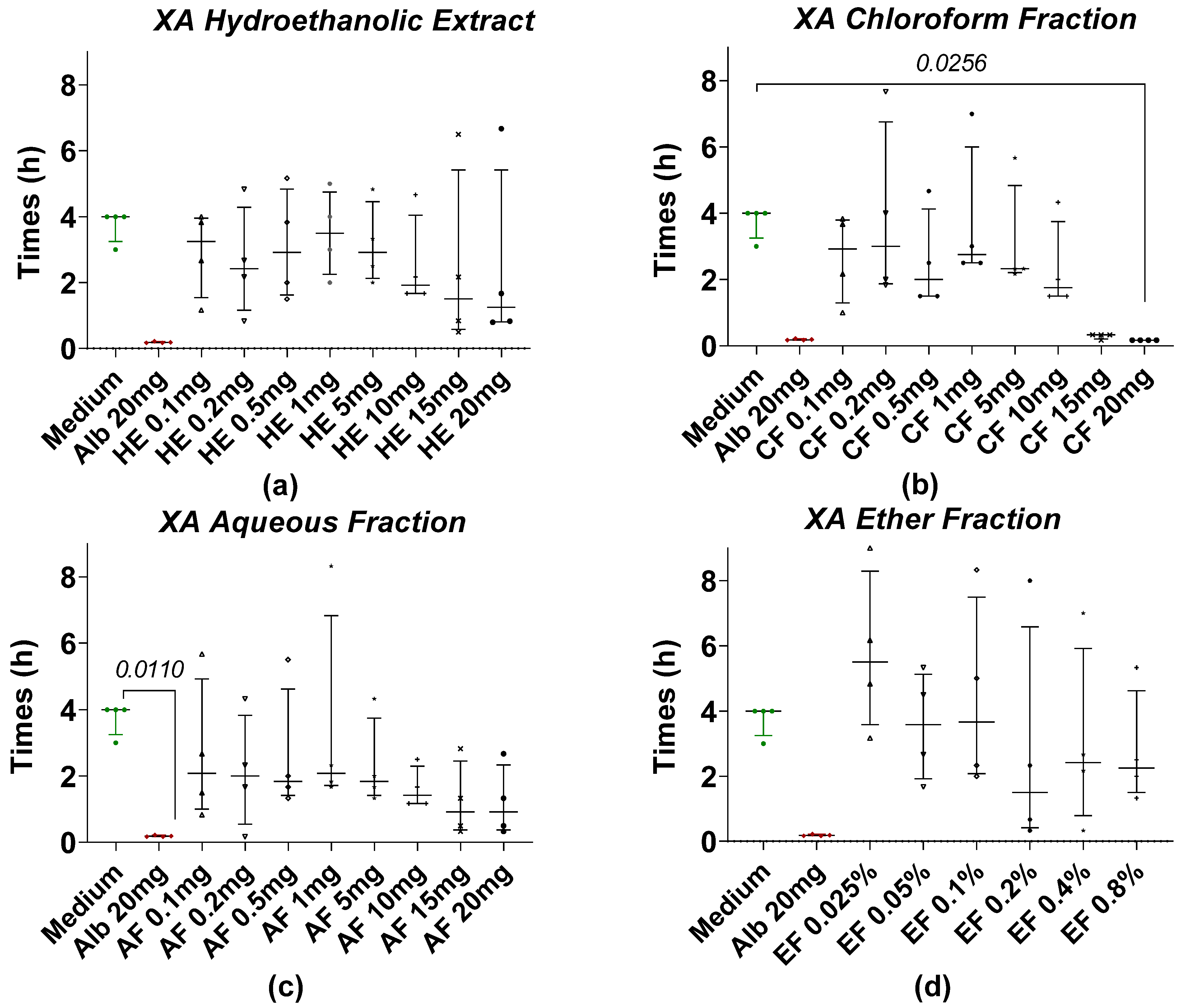
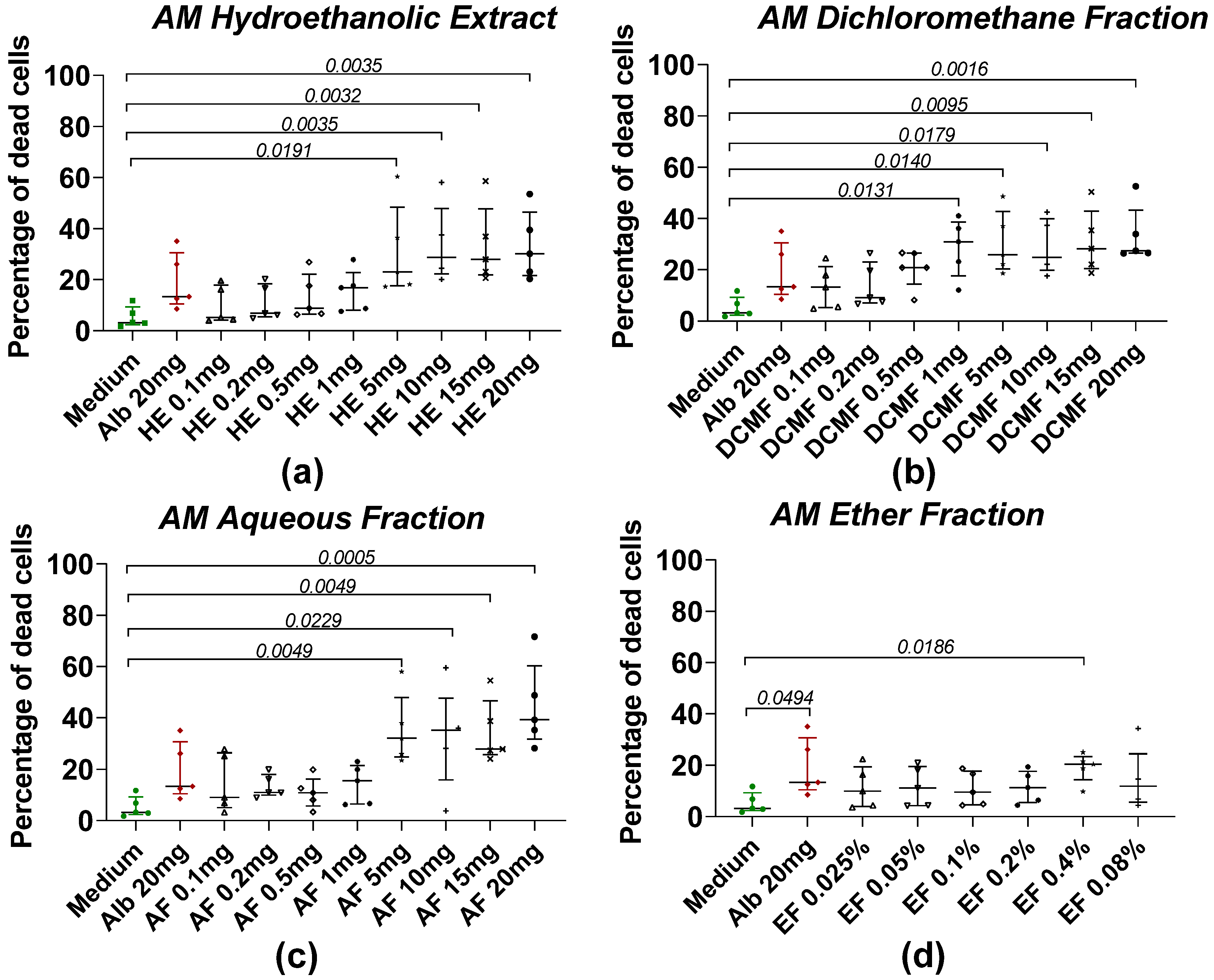
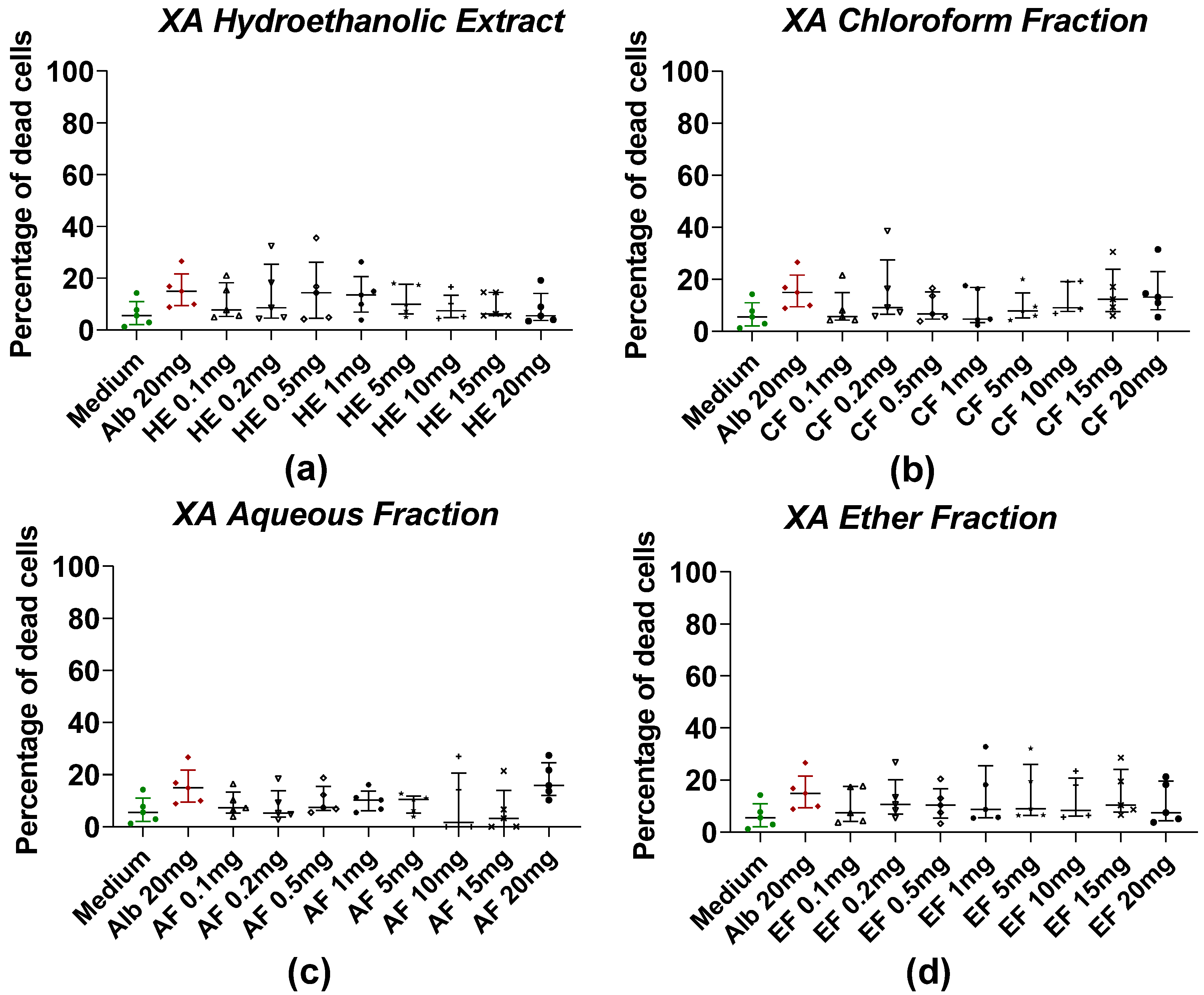
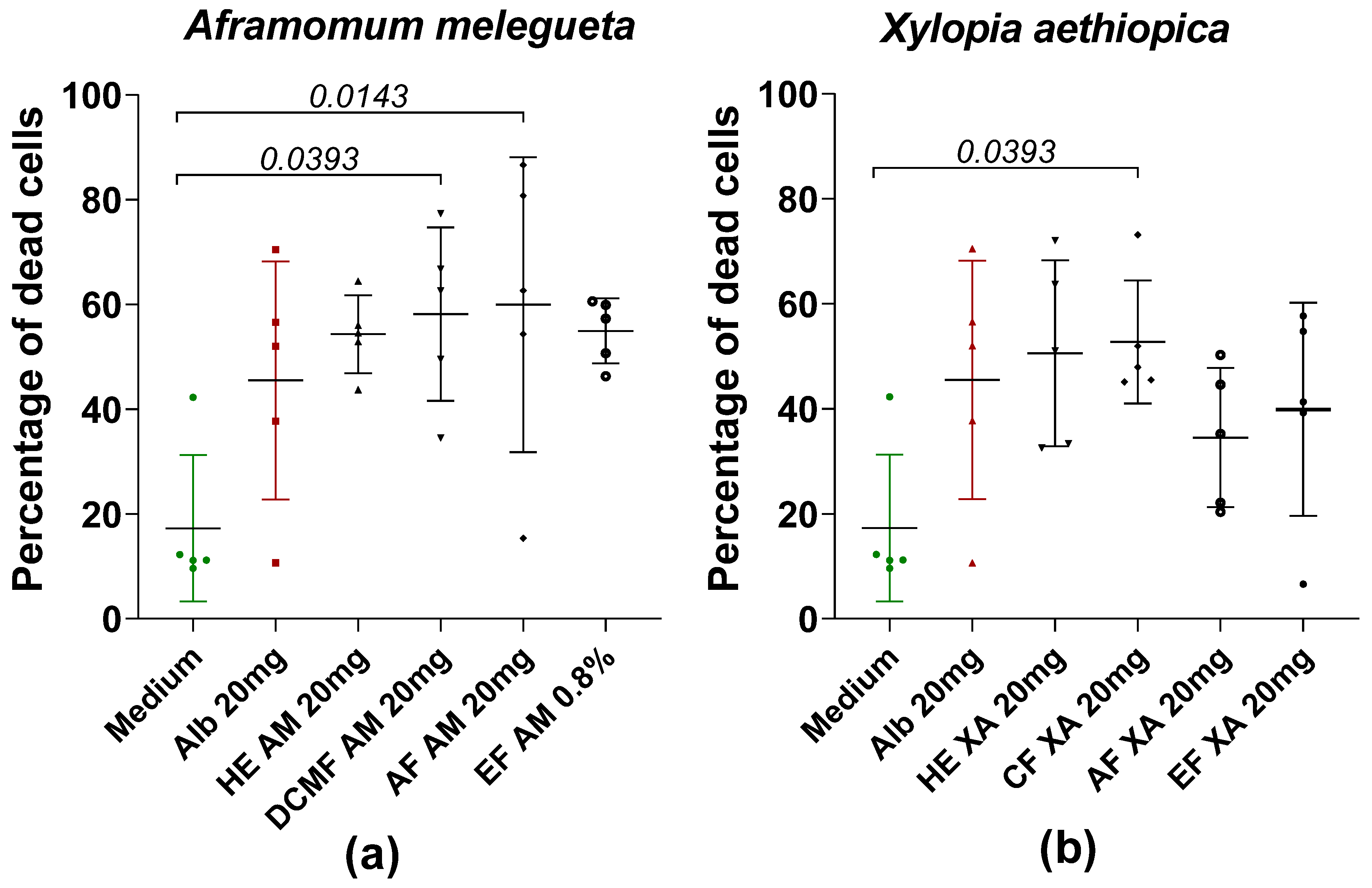

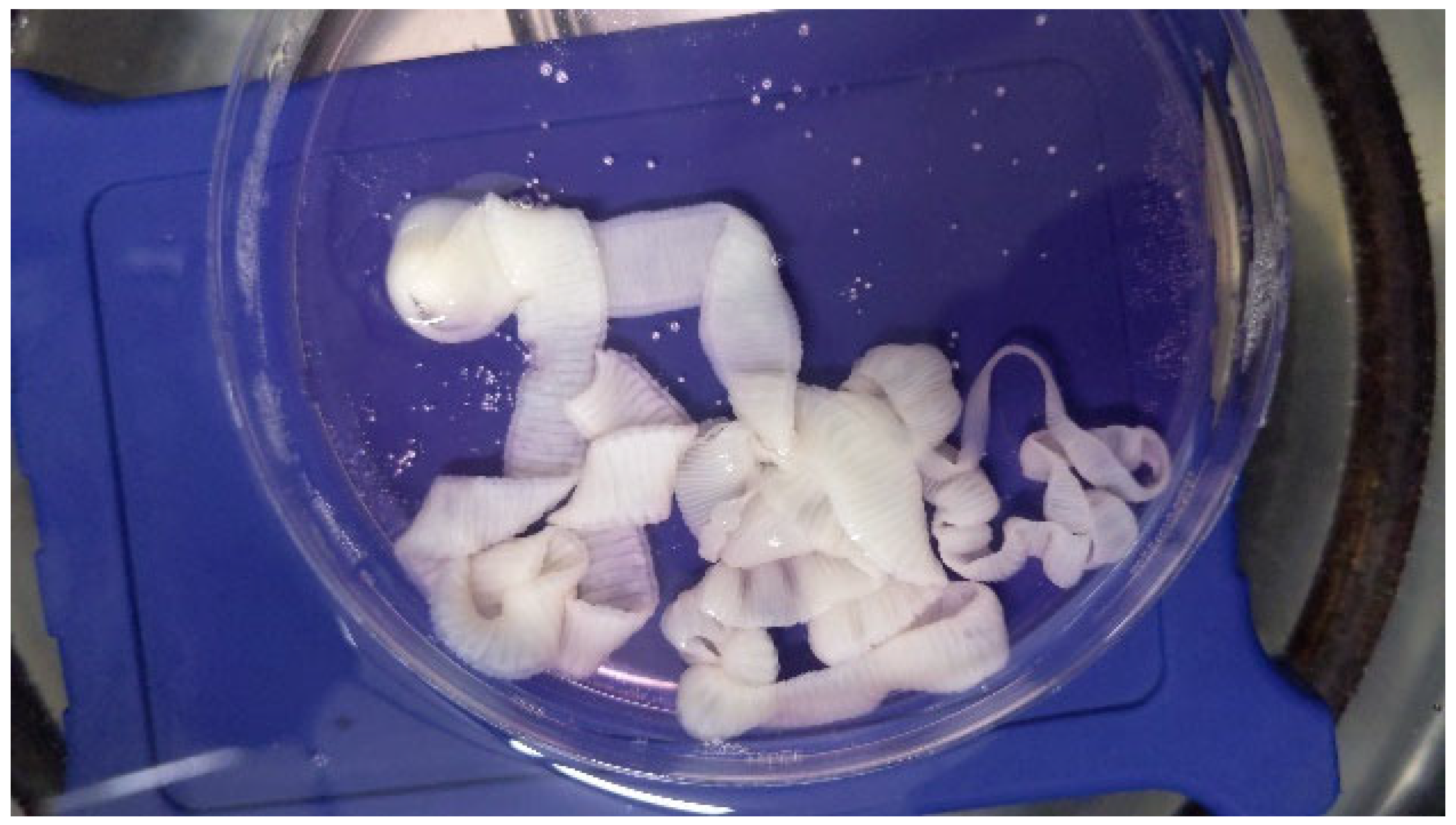
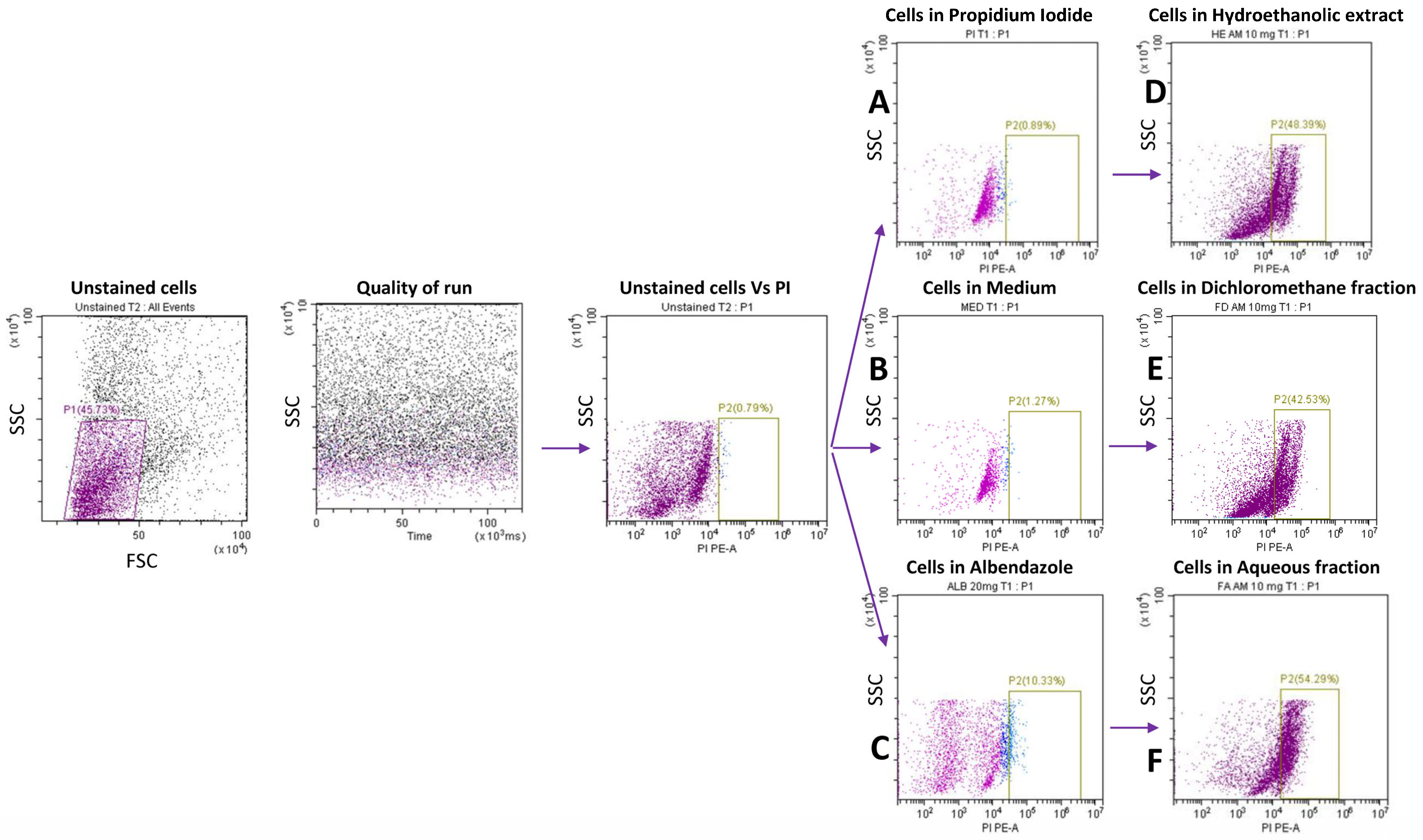
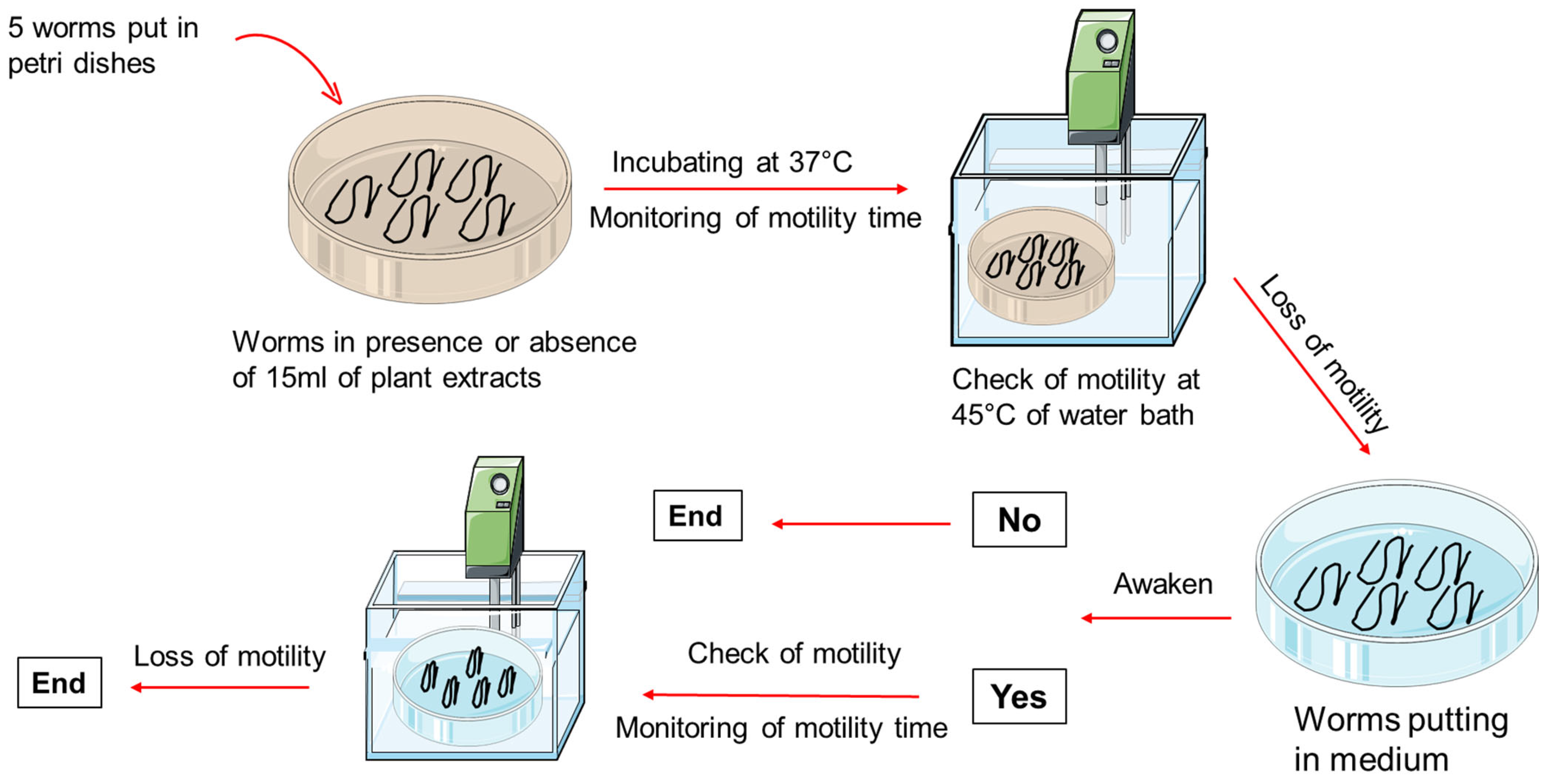
| Extracts | Concentrations (mg/mL) | Initial Time of Loss of Motility (h) | Transfer in Medium | |
|---|---|---|---|---|
| Wake Up Time (h) | Paralysis Time (h) | |||
| Medium | 4.82 | - | - | |
| A. melegueta | ||||
| HE | 10 | 1.16 | - | - |
| 15 | 1.06 | - | - | |
| 20 | 1 | - | - | |
| DCMF | 10 | 1.28 | 2.11 | 6 |
| 15 | 1.44 | - | - | |
| 20 | 0.94 | - | - | |
| AF | 10 | 1.78 | 0.17 | 0.33 |
| 15 | 1.72 | 0.17 | 0.50 | |
| 20 | 1.67 | 0.61 | 1.50 | |
| EF | 0.2% | 0.61 | - | - |
| 0.4% | 0.44 | - | - | |
| 0.8% | 0.28 | - | - | |
| X. aethiopica | ||||
| HE | 10 | 2.33 | - | - |
| 15 | 2.17 | - | - | |
| 20 | 2 | 0.17 | 0.21 | |
| CF | 10 | 3.22 | - | - |
| 15 | 2.94 | - | - | |
| 20 | 2.89 | 0.56 | 2 | |
| AF | 10 | 3.50 | 0.44 | 2 |
| 15 | 3.22 | 0.5 | 2 | |
| 20 | 2.94 | 0.56 | 2 | |
| EF | 0.2% | 2.17 | - | - |
| 0.4% | 3 | - | - | |
| 0.8% | 1.94 | - | - | |
Disclaimer/Publisher’s Note: The statements, opinions and data contained in all publications are solely those of the individual author(s) and contributor(s) and not of MDPI and/or the editor(s). MDPI and/or the editor(s) disclaim responsibility for any injury to people or property resulting from any ideas, methods, instructions or products referred to in the content. |
© 2025 by the authors. Licensee MDPI, Basel, Switzerland. This article is an open access article distributed under the terms and conditions of the Creative Commons Attribution (CC BY) license (https://creativecommons.org/licenses/by/4.0/).
Share and Cite
Douti, F.V.; Katawa, G.; Arndts, K.; Bara, F.D.; Awesso, E.R.; Karou, S.D.; Hoerauf, A.; Ritter, M. Potential of Aframomum melegueta and Xylopia aethiopica Against Taenia spp.: Plant-Based Remedies as Novel Anthelmintics. Pharmaceuticals 2025, 18, 749. https://doi.org/10.3390/ph18050749
Douti FV, Katawa G, Arndts K, Bara FD, Awesso ER, Karou SD, Hoerauf A, Ritter M. Potential of Aframomum melegueta and Xylopia aethiopica Against Taenia spp.: Plant-Based Remedies as Novel Anthelmintics. Pharmaceuticals. 2025; 18(5):749. https://doi.org/10.3390/ph18050749
Chicago/Turabian StyleDouti, Fekandine V., Gnatoulma Katawa, Kathrin Arndts, Fagdéba D. Bara, Essimanam R. Awesso, Simplice D. Karou, Achim Hoerauf, and Manuel Ritter. 2025. "Potential of Aframomum melegueta and Xylopia aethiopica Against Taenia spp.: Plant-Based Remedies as Novel Anthelmintics" Pharmaceuticals 18, no. 5: 749. https://doi.org/10.3390/ph18050749
APA StyleDouti, F. V., Katawa, G., Arndts, K., Bara, F. D., Awesso, E. R., Karou, S. D., Hoerauf, A., & Ritter, M. (2025). Potential of Aframomum melegueta and Xylopia aethiopica Against Taenia spp.: Plant-Based Remedies as Novel Anthelmintics. Pharmaceuticals, 18(5), 749. https://doi.org/10.3390/ph18050749












